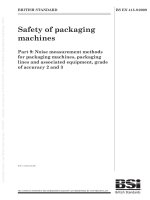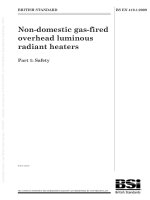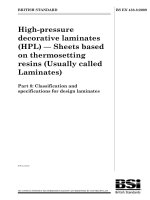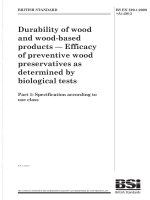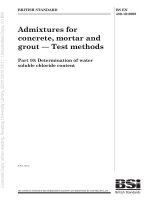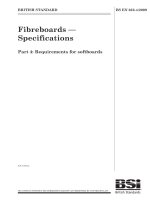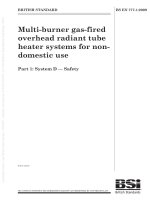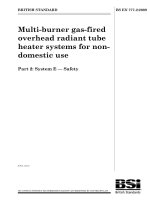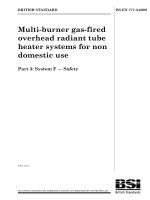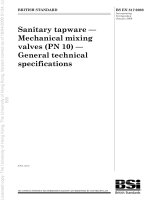Bsi bs en 62386 208 2009
Bạn đang xem bản rút gọn của tài liệu. Xem và tải ngay bản đầy đủ của tài liệu tại đây (1.68 MB, 78 trang )
BS EN 62386-208:2009
BSI Standards Publication
Digital addressable lighting
interface —
Part 208: Particular requirements for control gear —
Switching function (device type 7)
BRITISH STANDARD
BS EN 62386-208:2009
National foreword
This British Standard is the UK implementation of EN 62386-208:2009. It is
identical to IEC 62386-208:2009.
The UK participation in its preparation was entrusted by Technical Committee
CPL/34, Lamps and related equipment, to Subcommittee CPL/34/3, Auxiliaries
for lamps.
A list of organizations represented on this committee can be obtained on
request to its secretary.
This publication does not purport to include all the necessary provisions of a
contract. Users are responsible for its correct application.
© BSI 2009
ISBN 978 0 580 60938 1
ICS 29.130.99; 29.140.50; 29.140.99
Compliance with a British Standard cannot confer immunity from
legal obligations.
This British Standard was published under the authority of the Standards
Policy and Strategy Committee on 31 October 2009
Amendments issued since publication
Amd. No.
Date
Text affected
BS EN 62386-208:2009
EN 62386-208
EUROPEAN STANDARD
NORME EUROPÉENNE
EUROPÄISCHE NORM
August 2009
ICS 29.140.50; 29.140.99
English version
Digital addressable lighting interface Part 208: Particular requirements for control gear Switching function (device type 7)
(IEC 62386-208:2009)
Interface d'éclairage
adressable numérique Partie 208: Exigences particulières
pour les appareillages de commande Fonction de commutation
(dispositifs de type 7)
(CEI 62386-208:2009)
Digital adressierbare Schnittstelle
für die Beleuchtung Teil 208: Besondere Anforderungen
an Betriebsgeräte Schaltfunktion (Gerätetyp 7)
(IEC 62386-208:2009)
This European Standard was approved by CENELEC on 2009-07-01. CENELEC members are bound to comply
with the CEN/CENELEC Internal Regulations which stipulate the conditions for giving this European Standard
the status of a national standard without any alteration.
Up-to-date lists and bibliographical references concerning such national standards may be obtained on
application to the Central Secretariat or to any CENELEC member.
This European Standard exists in three official versions (English, French, German). A version in any other
language made by translation under the responsibility of a CENELEC member into its own language and notified
to the Central Secretariat has the same status as the official versions.
CENELEC members are the national electrotechnical committees of Austria, Belgium, Bulgaria, Cyprus, the
Czech Republic, Denmark, Estonia, Finland, France, Germany, Greece, Hungary, Iceland, Ireland, Italy, Latvia,
Lithuania, Luxembourg, Malta, the Netherlands, Norway, Poland, Portugal, Romania, Slovakia, Slovenia, Spain,
Sweden, Switzerland and the United Kingdom.
CENELEC
European Committee for Electrotechnical Standardization
Comité Européen de Normalisation Electrotechnique
Europäisches Komitee für Elektrotechnische Normung
Central Secretariat: Avenue Marnix 17, B - 1000 Brussels
© 2009 CENELEC -
All rights of exploitation in any form and by any means reserved worldwide for CENELEC members.
Ref. No. EN 62386-208:2009 E
BS EN 62386-208:2009
-2-
EN 62386-208:2009
Foreword
The text of document 34C/821/CDV, future edition 1 of IEC 62386-208, prepared by SC 34C, Auxiliaries
for lamps, of IEC TC 34, Lamps and related equipment, was submitted to the IEC-CENELEC parallel vote
and was approved by CENELEC as EN 62386-208 on 2009-07-01.
This Part 208 is intended to be used in conjunction with EN 62386-101 and EN 62386-102, which contain
general requirements for the relevant product type (control gear or control devices).
The following dates were fixed:
– latest date by which the EN has to be implemented
at national level by publication of an identical
national standard or by endorsement
(dop)
2010-04-01
– latest date by which the national standards conflicting
with the EN have to be withdrawn
(dow)
2012-07-01
Annex ZA has been added by CENELEC.
__________
Endorsement notice
The text of the International Standard IEC 62386-208:2009 was approved by CENELEC as a European
Standard without any modification.
In the official version, for Bibliography, the following notes have to be added for the standards indicated:
IEC 60598-1
NOTE Harmonized as EN 60598-1:2008 (modified).
IEC 60669-2-1
NOTE Harmonized as EN 60669-2-1:2004 (modified).
IEC 60921
NOTE Harmonized as EN 60921:2004 (not modified).
IEC 60923
NOTE Harmonized as EN 60923:2005 (not modified).
IEC 60925
NOTE Harmonized as EN 60925:1991 (not modified).
IEC 60929
NOTE Harmonized as EN 60929:2006 (not modified).
IEC 61347-1
NOTE Harmonized as EN 61347-1:2008 (modified).
IEC 61347-2-3
NOTE Harmonized as EN 61347-2-3:2001 (not modified).
IEC 61547
NOTE Harmonized as EN 61547:2009 (not modified).
CISPR 15
NOTE Harmonized as EN 55015:2006 (not modified).
__________
BS EN 62386-208:2009
EN 62386-208:2009
-3-
Annex ZA
(normative)
Normative references to international publications
with their corresponding European publications
The following referenced documents are indispensable for the application of this document. For dated
references, only the edition cited applies. For undated references, the latest edition of the referenced
document (including any amendments) applies.
NOTE When an international publication has been modified by common modifications, indicated by (mod), the relevant EN/HD
applies.
Publication
Year
Title
EN/HD
Year
IEC 62386-101
2009
Digital addressable lighting interface Part 101: General requirements - System
EN 62386-101
2009
IEC 62386-102
2009
Digital addressable lighting interface EN 62386-102
Part 102: General requirements - Control gear
2009
–2–
BS EN 62386-208:2009
62386-208 IEC:2009
CONTENTS
FOREWORD...........................................................................................................................5
INTRODUCTION.....................................................................................................................7
1
Scope ...............................................................................................................................8
2
Normative references .......................................................................................................8
3
Terms and definitions .......................................................................................................8
4
General description ..........................................................................................................8
5
Electrical specification ......................................................................................................9
6
Interface power supply .....................................................................................................9
7
Transmission protocol structure ........................................................................................9
8
Timing ..............................................................................................................................9
9
Method of operation .........................................................................................................9
10 Declaration of variables .................................................................................................. 11
11 Definition of commands .................................................................................................. 12
12 Test procedures ............................................................................................................. 18
Annex A (informative) Examples of algorithms ..................................................................... 70
Bibliography.......................................................................................................................... 71
Figure 1 – Example of a possible configuration ..................................................................... 11
Figure 2 – Application extended configuration command sequence example ......................... 13
Figure 3 – Test sequence QUERY FEATURES ..................................................................... 19
Figure 4 – Test sequence Reset State / Persistent Memory .................................................. 20
Figure 5 – Test sequence QUERY LOAD ERROR ................................................................. 22
Figure 6 – Test sequence QUERY LOAD ERROR with HOLD-OFF TIME .............................. 23
Figure 7 – Test sequence QUERY LOAD ERROR with indefinitely HOLD-OFF TIME ............ 24
Figure 8 – Test sequence QUERY Control Gear Information ................................................. 25
Figure 9 – Test sequence REFERENCE SYSTEM POWER................................................... 26
Figure 10 – Test sequence REFERENCE SYSTEM POWER: 100 ms-timeout ....................... 27
Figure 11 – Test sequence REFERENCE SYSTEM POWER: Command in-between ............. 28
Figure 12 – Test sequence REFERENCE SYSTEM POWER: 15 min timer............................ 29
Figure 13 – Test sequence REFERENCE SYSTEM POWER: failed ...................................... 30
Figure 14 – Test sequence THRESHOLDS: Configuration Sequence .................................... 31
Figure 15 – Test sequence ERROR HOLD-OFF TIME: Configuration Sequence ................... 33
Figure 16 – Test sequence STORE DTR AS THRESHOLD X ................................................ 34
Figure 17 – Test sequence STORE DTR AS MIN / MAX LEVEL ............................................ 35
Figure 18 – Test sequence STORE DTR AS ERROR HOLD-OFF TIME ................................ 36
Figure 19 – Test sequence ENABLE DEVICE TYPE: Appl. extended query commands ......... 37
Figure 20 – Test sequence ENABLE DEVICE TYPE: Reference System Power .................... 38
Figure 21 – Test sequence ENABLE DEVICE TYPE: Other Application Extended
Configuration Commands...................................................................................................... 39
Figure 22 – Test sequence ENABLE DEVICE TYPE: Error Hold-Off Time ............................. 41
Figure 23 – Test sequence ENABLE DEVICE TYPE: Application Extended
Configuration Commands 2 ................................................................................................... 42
BS EN 62386-208:2009
62386-208 IEC:2009
–3–
Figure 24 – Test sequence DEFAULT ON AND OFF ............................................................. 44
Figure 25 – Test sequence DEFAULT OFF WITH FADING ................................................... 45
Figure 26 – Test sequence SWITCHING ON AND OFF – FULL RANGE................................ 47
Figure 27 – Test sequence SWITCHING ON AND OFF – LIMITED RANGE .......................... 51
Figure 28 – Test sequence VIRTUAL DIMMING – FADE TIME.............................................. 54
Figure 29 – Test sequence VIRTUAL DIMMING – FADE RATE ............................................. 56
Figure 30 – Test sequence SWITCHING ON AND OFF – IAPC ............................................. 57
Figure 31 – Test sequence SWITCHING ON AND OFF – ADJUSTING THRESHOLDS ......... 58
Figure 32 – Test sequence SWITCHING ON AND OFF – ADJUSTING MIN/MAX .................. 60
Figure 33 – Test sequence SWITCHING ON AND OFF – DEFAULT POL/SYS ...................... 62
Figure 34 – Test sequence SWITCHING ON AND OFF – POWER ON .................................. 64
Figure 35 – Test sequence SWITCHING ON AND OFF – SYSTEM FAILURE........................ 66
Figure 36 – Test sequence QUERY EXTENDED VERSION NUMBER ................................... 68
Figure 37 – Test sequence RESERVED APPLICATION EXTENDED COMMANDS................ 69
Figure A.1 – Examples of switching characteristics ............................................................... 70
Table 1 – virtual arc power level (VAPL) ............................................................................... 11
Table 2 – Declaration of variables ......................................................................................... 12
Table 3 – Summary of the application extended command set .............................................. 18
Table 4 – Parameters for the test sequence State / Persistent Memory................................. 21
Table 5 – Test step QUERY LOAD ERROR with HOLD-OFF TIME........................................ 23
Table 6 – Test steps REFERENCE SYSTEM POWER: Command in-between ....................... 28
Table 7 – Test parameter and test steps 1 THRESHOLDS: Configuration Sequence............. 31
Table 8 – Test parameter and test steps 2 THRESHOLDS: Configuration Sequence............. 32
Table 9 – Test parameter and test steps 3 THRESHOLDS: Configuration Sequence............. 32
Table 10 – Test steps ERROR HOLD-OFF TIME: Configuration Sequence ........................... 33
Table 11 – Test steps STORE DTR AS THRESHOLD X ........................................................ 34
Table 12 – Test steps STORE DTR AS MIN / MAX LEVEL .................................................... 35
Table 13 – Test steps STORE DTR AS ERROR HOLD-OFF TIME ........................................ 36
Table 14 – Test steps ENABLE DEVICE TYPE: Appl. extended query commands................. 37
Table 15 – Test steps ENABLE DEVICE TYPE: Reference System Power ............................ 38
Table 16 – Test steps 1 ENABLE DEVICE TYPE: Other Application Extended
Configuration Commands...................................................................................................... 40
Table 17 – Test steps 2 ENABLE DEVICE TYPE: Other Application Extended
Configuration Commands...................................................................................................... 40
Table 18 – Test steps 3 ENABLE DEVICE TYPE: Other Application Extended
Configuration Commands...................................................................................................... 40
Table 19 – Test steps ENABLE DEVICE TYPE: Error Hold-Off Time ..................................... 41
Table 20 – Test steps 1 ENABLE DEVICE TYPE: Application Extended Configuration
Commands 2 ........................................................................................................................ 43
Table 21 – Test steps 2 ENABLE DEVICE TYPE: Application Extended Configuration
Commands 2 ........................................................................................................................ 43
Table 22 – Test steps DEFAULT ON AND OFF ..................................................................... 44
Table 23 – Test steps 1 DEFAULT OFF WITH FADING ........................................................ 45
–4–
BS EN 62386-208:2009
62386-208 IEC:2009
Table 24 – Test steps 2 DEFAULT OFF WITH FADING ........................................................ 46
Table 25 – Test steps and parameter 1 SWITCHING ON AND OFF – FULL RANGE ............. 48
Table 26 – Test steps and parameter 2 SWITCHING ON AND OFF – FULL RANGE ............. 48
Table 27 – Test steps and parameter 3 SWITCHING ON AND OFF – FULL RANGE ............. 48
Table 28 – Test steps and parameter 4 SWITCHING ON AND OFF – FULL RANGE ............. 49
Table 29 – Test steps and parameter 5 SWITCHING ON AND OFF – FULL RANGE ............. 50
Table 30 – Test steps and parameter 1 SWITCHING ON AND OFF – LIMITED RANGE ........ 52
Table 31 – Test steps and parameter 2 SWITCHING ON AND OFF – LIMITED RANGE ........ 52
Table 32 – Test steps and parameter 3 SWITCHING ON AND OFF – LIMITED RANGE ........ 52
Table 33 – Test steps and parameter 4 SWITCHING ON AND OFF – LIMITED RANGE ........ 53
Table 34 – Test steps and parameter 5 SWITCHING ON AND OFF – LIMITED RANGE ........ 53
Table 35 – Test steps and parameter 1 VIRTUAL DIMMING – FADE TIME ........................... 54
Table 36 – Test steps and parameter 2 VIRTUAL DIMMING – FADE TIME ........................... 55
Table 37 – Test steps and parameter 3 VIRTUAL DIMMING – FADE TIME ........................... 55
Table 38 – Test steps VIRTUAL DIMMING – FADE RATE..................................................... 56
Table 39 – Test steps SWITCHING ON AND OFF – IAPC ..................................................... 57
Table 40 – Test steps and parameter 1 SWITCHING ON AND OFF – ADJUSTING
THRESHOLDS...................................................................................................................... 59
Table 41 – Test steps and parameter 2 SWITCHING ON AND OFF – ADJUSTING
THRESHOLDS...................................................................................................................... 59
Table 42 – Test steps and parameter 3 SWITCHING ON AND OFF – ADJUSTING
THRESHOLDS...................................................................................................................... 59
Table 43 – Test steps and parameter 1 SWITCHING ON AND OFF – ADJUSTING
MIN/MAX .............................................................................................................................. 60
Table 44 – Test steps and parameter 2 SWITCHING ON AND OFF – ADJUSTING
MIN/MAX .............................................................................................................................. 61
Table 45 – Test steps and parameter 3 SWITCHING ON AND OFF – ADJUSTING
MIN/MAX .............................................................................................................................. 61
Table 46 – Test steps and parameter 1 SWITCHING ON AND OFF – DEFAULT
POL/SYS .............................................................................................................................. 62
Table 47 – Test steps and parameter 2 SWITCHING ON AND OFF – DEFAULT
POL/SYS .............................................................................................................................. 63
Table 48 – Test steps and parameter 1 SWITCHING ON AND OFF – POWER ON ............... 64
Table 49 – Test steps and parameter 2 SWITCHING ON AND OFF – POWER ON ............... 65
Table 50 – Test steps and parameter 1 SWITCHING ON AND OFF – SYSTEM
FAILURE .............................................................................................................................. 66
Table 51 – Test steps and parameter 2 SWITCHING ON AND OFF – SYSTEM
FAILURE .............................................................................................................................. 67
Table 52 – Test steps RESERVED APPLICATION EXTENDED COMMANDS ....................... 69
BS EN 62386-208:2009
62386-208 IEC:2009
–5–
INTERNATIONAL ELECTROTECHNICAL COMMISSION
____________
DIGITAL ADDRESSABLE LIGHTING INTERFACE –
Part 208: Particular requirements for control gear –
Switching function (device type 7)
FOREWORD
1) The International Electrotechnical Commission (IEC) is a worldwide organization for standardization comprising
all national electrotechnical committees (IEC National Committees). The object of the IEC is to promote
international co-operation on all questions concerning standardization in the electrical and electronic fields. To
this end and in addition to other activities, IEC publishes International Standards, Technical Specifications,
Technical Reports, Publicly Available Specifications (PAS) and Guides (hereafter referred to as "IEC
Publication(s)"). Their preparation is entrusted to technical committees; any IEC National Committee interested
in the subject dealt with may participate in this preparatory work. International, governmental and nongovernmental organizations liaising with the IEC also participate in this preparation. IEC collaborates closely
with the International Organization for Standardization (ISO) in accordance with conditions determined by
agreement between the two organizations.
2) The formal decisions or agreements of IEC on technical matters express, as nearly as possible, an international
consensus of opinion on the relevant subjects since each technical committee has representation from all
interested IEC National Committees.
3) IEC Publications have the form of recommendations for international use and are accepted by IEC National
Committees in that sense. While all reasonable efforts are made to ensure that the technical content of IEC
Publications is accurate, IEC cannot be held responsible for the way in which they are used or for any
misinterpretation by any end user.
4) In order to promote international uniformity, IEC National Committees undertake to apply IEC Publications
transparently to the maximum extent possible in their national and regional publications. Any divergence
between any IEC Publication and the corresponding national or regional publication shall be clearly indicated in
the latter.
5) IEC provides no marking procedure to indicate its approval and cannot be rendered responsible for any
equipment declared to be in conformity with an IEC Publication.
6) All users should ensure that they have the latest edition of this publication.
7) No liability shall attach to IEC or its directors, employees, servants or agents including individual experts and
members of its technical committees and IEC National Committees for any personal injury, property damage or
other damage of any nature whatsoever, whether direct or indirect, or for costs (including legal fees) and
expenses arising out of the publication, use of, or reliance upon, this IEC Publication or any other IEC
Publications.
8) Attention is drawn to the Normative references cited in this publication. Use of the referenced publications is
indispensable for the correct application of this publication.
9) Attention is drawn to the possibility that some of the elements of this IEC Publication may be the subject of
patent rights. IEC shall not be held responsible for identifying any or all such patent rights.
International Standard IEC 62386-208 has been prepared by subcommittee 34C: Auxiliaries
for lamps, of IEC technical committee 34: Lamps and related equipment.
The text of this standard is based on the following documents:
CDV
Report on voting
34C/821/CDV
34C/842/RVC
Full information on the voting for the approval of this standard can be found in the report on
voting indicated in the above table.
This publication has been drafted in accordance with the ISO/IEC Directives, Part 2.
–6–
BS EN 62386-208:2009
62386-208 IEC:2009
This Part 208 is intended to be used in conjunction with IEC 62386-101 and IEC 62386-102,
which contain general requirements for the relevant product type (control gear or control
devices).
A list of all parts of the IEC 62386 series, under the general title Digital addressable lighting
interface, can be found on the IEC website.
The committee has decided that the contents of this publication will remain unchanged until
the maintenance result date indicated on the IEC website under in the
data related to the specific publication. At this date, the publication will be
•
•
•
•
reconfirmed;
withdrawn;
replaced by a revised edition, or
amended.
BS EN 62386-208:2009
62386-208 IEC:2009
–7–
INTRODUCTION
This first edition of IEC 62386-208 is published in conjunction with IEC 62386-101 and
IEC 62386-102. The division of IEC 62386 into separately published parts provides for ease
of future amendments and revisions. Additional requirements will be added as and when a
need for them is recognized.
This International Standard, and the other parts that make up the IEC 62386-200 series, in
referring to any of the clauses of IEC 62386-101 or IEC 62386-102, specify the extent to
which such a clause is applicable and the order in which the tests are to be performed. The
parts also include additional requirements, as necessary. All parts that make up the
IEC 62386-200 series are self-contained and therefore do not include references to each
other.
Where the requirements of any of the clauses of IEC 62386-101 or IEC 62386-102 are
referred to in this International Standard by the sentence "The requirements of IEC 623861XX, clause ‘n’ apply”, this sentence is to be interpreted as meaning that all requirements of
the clause in question of Part 101 or Part 102 apply, except any which are inapplicable to the
specific type of lamp control gear covered by Part 208.
All numbers used in this International Standard are decimal numbers unless otherwise noted.
Hexadecimal numbers are given in the format 0xVV, where VV is the value. Binary numbers
are given in the format XXXXXXXXb or in the format XXXX XXXX, where X is 0 or 1; "x" in
binary numbers means "don't care".
–8–
BS EN 62386-208:2009
62386-208 IEC:2009
DIGITAL ADDRESSABLE LIGHTING INTERFACE –
Part 208: Particular requirements for control gear –
Switching function (device type 7)
1
Scope
This International Standard specifies a protocol and test methods for the control by digital
signals of electronic control gear that switches its output only on and off.
2
Normative references
The following referenced documents are indispensable for the application of this document.
For dated references, only the edition cited applies. For undated references, the latest edition
of the referenced document (including any amendments) applies.
IEC 62386-101:2009, Digital addressable lighting interface – Part 101: General requirements
– System
IEC 62386-102:2009, Digital addressable lighting interface — Part 102: General requirements
– Control gear
3
Terms and definitions
For the purposes of this document, the terms and definitions given in Clause 3 of
IEC 62386-101:2009 and Clause 3 of IEC 62386-102:2009 shall apply, with the following
additional definitions.
3.1
virtual arc power level
value calculated by the control gear during virtual dimming. It corresponds to the actual level
of a dimmable control gear
3.2
virtual dimming
attribute of the control gear for treating arc power commands in the same way as a dimmable
control gear. It provides virtual dimming by calculating a virtual arc power level in accordance
with the appropriate fading definition, thus requiring the output state to change when the
virtual arc power level reaches or passes a threshold
3.3
up switch-on threshold
value against which the virtual arc power level is continually compared, the output of the
control gear being switched on whenever the virtual arc power level reaches or passes this
level whilst increasing
3.4
up switch-off threshold
value against which the virtual arc power level is continually compared, the output of the
control gear being switched off whenever the virtual arc power level reaches or passes this
level whilst increasing
BS EN 62386-208:2009
62386-208 IEC:2009
–9–
3.5
down switch-on threshold
value against which the virtual arc power level is continually compared, the output of the
control gear being switched on whenever the virtual arc power level reaches or passes this
level whilst decreasing
3.6
down switch-off threshold
value against which the virtual arc power level is continually compared, the output of the
control gear being switched off whenever the virtual arc power level reaches or passes this
level whilst decreasing
4
General description
The requirements of Clause 4 of IEC 62386-101:2009 and Clause 4 of IEC 62386-102:2009
shall apply.
5
Electrical specification
The requirements of Clause 5 of IEC 62386-101:2009 and Clause 5 of IEC 62386-102:2009
shall apply.
6
Interface power supply
The requirements of Clause 6 of IEC 62386-101:2009 and Clause 6 of IEC 62386-102:2009
shall apply if a power supply unit is integrated into the switching control gear.
7
Transmission protocol structure
The requirements of Clause 7 of IEC 62386-101:2009 and Clause 7 of IEC 62386-102:2009
shall apply.
8
Timing
The requirements of Clause 8 of IEC 62386-101:2009 and Clause 8 of IEC 62386-102:2009
shall apply.
9
Method of operation
The requirements of Clause 9 of IEC 62386-101:2009 and Clause 9 of IEC 62386-102:2009
shall apply with the following exceptions:
Amendments to Clause 9 of IEC 62386-102:2009:
9.2
Power-On
Addition:
If no command affecting power level is received before 0,6 s after mains power-on, the control
gear shall set the virtual arc power level (VAPL) to the POWER-ON LEVEL immediately
without fading.
– 10 –
BS EN 62386-208:2009
62386-208 IEC:2009
In this case the VAPL shall be compared against the two up-threshold parameters to
determine the output state. If the output state cannot be determined because the VAPL is
below the thresholds, then the output shall be switched off, unless the UP Switch-On
Threshold is set to “MASK”, in which case the output shall be switched on.
If “MASK” is stored as the POWER ON LEVEL the VAPL shall be set to the last VAPL before
mains power-down and the output state shall be determined according to the last threshold
reached or passed (as indicated by bits 2 and 3 of the SWITCH STATUS byte).
9.3
Interface-failure
Addition:
If "MASK" is stored as SYSTEM FAILURE LEVEL, the control gear shall stay in the state it is
in (no change of the virtual arc power level, no switching on or off). If any other value is
stored, the control gear shall go to this virtual arc power level immediately without fading. On
restoration of the idle voltage the control gear shall not change its state.
NOTE The actual output state will also depend on the dim direction. This has to be considered in some threshold
configurations (e.g. switching hysteresis).
9.4
Min and max level
Addition:
The MIN LEVEL and the MAX LEVEL are used to define the range of virtual dimming:
The control gear shall check each received Arc Power Level against the MIN LEVEL and the
MAX LEVEL before virtual dimming is performed.
Programming a MIN LEVEL above or a MAX LEVEL below the virtual arc power level shall set
the virtual arc power level to the new MIN LEVEL or MAX LEVEL immediately without fading.
If this causes the virtual arc power level to reach or pass a threshold, the output state shall
change accordingly.
Programming a MIN LEVEL below or a MAX LEVEL above the virtual arc power level shall not
be affecting the virtual arc power level.
Arc power levels stored in the control gear shall not be restricted by the MIN and MAX LEVEL
settings. Nevertheless, those levels shall cause the virtual arc power level to be set to the
MIN LEVEL or MAX LEVEL if the stored value is below the MIN LEVEL or above the
MAX LEVEL.
The arc power levels "0" (OFF) and "255" (MASK) shall not be affected by the MIN and
MAX LEVEL settings.
If the control gear does not support programmable thresholds the MIN LEVEL and the MAX
LEVEL are fixed at the default values.
Additional subclause:
9.9
Switching characteristics
Different switching characteristics can be achieved by programming the parameters UP
SWITCH-ON THRESHOLD, UP SWITCH-OFF THRESHOLD, DOWN SWITCH-ON
THRESHOLD and DOWN SWITCH-OFF THRESHOLD.
BS EN 62386-208:2009
62386-208 IEC:2009
– 11 –
The control gear shall continually compare the virtual arc power level (VAPL) against the four
threshold parameters. The output shall be switched on or off in accordance with the result of
the comparison and the current direction of dimming (see Table 1).
Table 1 – virtual arc power level (VAPL)
Dimming direction
(virtual)
Result of comparison
Action
Up
VAPL ≥ up switch-on threshold
Switch the output on
Up
VAPL ≥ up switch-off threshold
Switch the output off
Down
VAPL ≤ down switch-on threshold
Switch the output on
Down
VAPL ≤ down switch-off threshold
Switch the output off
A threshold with the value ‘MASK’ shall not be used for the comparison.
If a pair of thresholds (“up-pair” or “down-pair”) is programmed to the same value, switching
on takes priority.
Programming a threshold shall not initiate a comparison and the output shall remain
unchanged.
If the control gear does not support programmable thresholds, the thresholds are fixed at the
default values.
Figure 1 gives an example of a possible configuration. More examples can be found in Annex
A.
Arc Power Level
254
Up Switch-On
Threshold
Up Switch-Off Threshold = “MASK”
Down Switch-On Threshold = “MASK“
Down Switch-Off
Threshold
Lamp
1
0
t
ON
OFF
IEC
1867/08
Figure 1 – Example of a possible configuration
10 Declaration of variables
The requirements of Clause 10 of IEC 62386-101:2009 and Clause 10 of IEC 62386-102:2009
shall apply, with the following adaptations and additional variables for this device type
indicated in Table 2:
BS EN 62386-208:2009
62386-208 IEC:2009
– 12 –
Table 2 – Declaration of variables
Variable
Default value
Reset value
Range of
validity
Memorya
(control gear leaves
the factory)
"PHYSICAL MIN. LEVEL"
254
No change
254
1 byte ROM
"MIN LEVEL"
254
254
1 – MAX LEVEL
1 byte
"MAX LEVEL"
254
254
MIN LEVEL – 254
1 byte
“UP SWITCH-ON
THRESHOLD”
1
1
1 – 254,
255 (‘MASK’)
1 byte
“UP SWITCH-OFF
THRESHOLD”
255
255
1 – 254,
255 (‘MASK’)
1 byte
“DOWN SWITCH-ON
THRESHOLD”
255
255
0 – 254,
255 (‘MASK’)
1 byte
“DOWN SWITCH-OFF
THRESHOLD”
0
0
0 – 254,
255 (‘MASK’)
1 byte
“ERROR HOLD-OFF TIME”
0
0
0 – 255
1 byte
“FEATURES”
Factory burn-in
No change
0 – 255
1 byte ROM
“GEAR TYPE”
Factory burn-in
No change
0 – 255
1 byte ROM
No change
0 – 255
1 byte RAM c
“SWITCH STATUS”
U000 0UUU
b
U = undefined
a
Persistent memory (storage time indefinite) if not stated otherwise.
b
Power up value
c
Bits 2, 3 and 7 of this byte shall be stored in the persistent memory
11 Definition of commands
The requirements of Clause 11 of IEC 62386-101:2009 and Clause 11 of IEC 62386102:2009, shall apply with the following exceptions:
11.1
Arc power control commands
Addition:
For all arc power control commands the following rule applies: Actual Arc Power Level =
virtual arc power level.
A received arc power control command shall affect the virtual arc power level.
Whenever the definition of an arc power control command requires the lamp (load) to be
switched off, the virtual arc power level shall be set to 0. If the virtual arc power level is 0 and
command 8 “ON AND STEP UP” is received, the virtual arc power level shall be set to MIN
LEVEL.
The Actual Arc Power Level (and so the output state) shall only change when the virtual arc
power level reaches, passes or leaves a threshold.
11.2.1
General configuration commands
Amendment:
BS EN 62386-208:2009
62386-208 IEC:2009
– 13 –
Command 33: YAAA AAA1 0010 0001
"STORE ACTUAL LEVEL IN THE DTR"
Store virtual arc power level in the DTR.
11.3.1
Queries related to status information
Amendment
Command 144:
YAAA AAA1 1001 0000
"QUERY STATUS"
Bit 4 “Fade running” shall be set during a virtual dimming process.
Command 153:
YAAA AAA1 1001 1001
"QUERY DEVICE TYPE"
The answer shall be 7.
11.3.2
Queries related to arc power parameter settings
Amendment:
Command 160:
YAAA AAA1 1010 0000
"QUERY ACTUAL LEVEL"
The answer shall be “0” if the load is switched off or “254” if the load is switched on. During
preheating (if applicable) or if a load error is detected the answer shall be "MASK".
11.3.4
Application extended commands
Replacement:
Application extended commands shall be preceded by command 272 ‘ENABLE DEVICE TYPE
7’.
NOTE
For device types other than 7, these commands may be used in a different way.
A switching control gear with only switching function shall not react to application extended
commands preceded by command 272 ‘ENABLE DEVICE TYPE X’ with X ≠ 7.
11.3.4.1
Application extended configuration commands
Every configuration command (224 – 239) shall be received a second time within 100 ms
(nominal) before it is executed in order to reduce the probability of incorrect reception. No
other commands addressing the same control gear shall be sent between these two
commands, otherwise the first such command shall be ignored and the respective
configuration sequence aborted.
Command 272 must be sent before the two instances of the respective configuration
command, but not repeated between them (see Figure 2).
Command 272
Application extended
configuration
command
Application extended
configuration
command
Max. 100 ms
IEC
1797/08
Figure 2 – Application extended configuration command sequence example
All values of DTR shall be checked against the values mentioned in Clause 10, RANGE OF
VALIDITY, i.e. the value shall be set to the upper / lower limit if it is above / below the valid
range defined in Clause 10.
BS EN 62386-208:2009
62386-208 IEC:2009
– 14 –
Command 224:
YAAA AAA1 1110 0000
‘REFERENCE SYSTEM POWER’
The switching control gear shall measure and store the system power level in order to detect
load errors. The measured power level shall be stored in the persistent memory. Commands
received during the measuring period shall be ignored except query commands and command
256.
After 15 min at most the switching control gear shall finish the measurement process and
shall go back to normal operation. The measurement process shall be aborted if command
256 ‘TERMINATE’ is received.
When there has been no successful reference measurement or the most recent reference
measurement was unsuccessful, bit 7, reference measurement failed, in the answer to
command 240 ‘QUERY FAILURE STATUS’ shall be set and command 249 ‘QUERY
REFERENCE MEASUREMENT FAILED’ shall be answered with ‘Yes’.
This is an optional feature. Control gear without this feature shall not react (see command
240) and bit 7 in the FAILURE STATUS shall be always being zero.
Command 225:
YAAA AAA1 1110 0001
‘STORE DTR
THRESHOLD’
AS
UP
SWITCH-ON
Store the content of the DTR as new UP SWITCH-ON THRESHOLD.
If 255 (‘MASK’) is stored, the threshold shall not be used for comparison.
This is an optional feature. Switching control gear without this feature shall not react.
Command 226:
YAAA AAA1 1110 0010
‘STORE DTR
THRESHOLD’
AS
UP
SWITCH-OFF
Store the content of the DTR as new UP SWITCH-OFF THRESHOLD.
If 255 (‘MASK’) is stored, the threshold shall not be used for comparison.
This is an optional feature. Switching control gear without this feature shall not react.
Command 227:
YAAA AAA1 1110 0011
‘STORE DTR AS DOWN SWITCH-ON
THRESHOLD’
Store the content of the DTR as new DOWN SWITCH-ON THRESHOLD.
If 255 (‘MASK’) is stored, the threshold shall not be used for comparison.
This is an optional feature. Switching control gear without this feature shall not react.
Command 228:
YAAA AAA1 1110 0100
‘STORE DTR AS DOWN SWITCH-OFF
THRESHOLD’
Store the content of the DTR as new DOWN SWITCH-OFF THRESHOLD.
If 255 (‘MASK’) is stored, the threshold shall not be used for comparison.
This is an optional feature. Switching control gear without this feature shall not react.
Command 229:
YAAA AAA1 1110 0101
‘STORE DTR AS ERROR HOLD-OFF
TIME’
Store the content of the DTR as new ERROR HOLD-OFF TIME value in units of 10 s.
The ERROR HOLD-OFF TIME specifies the minimum time an error must be continuously
present in order to be indicated.
BS EN 62386-208:2009
62386-208 IEC:2009
– 15 –
If 0 is stored, a load error shall be indicated immediately.
If 255 ('MASK') is stored, a load error shall not be indicated.
This is an optional feature. Switching control gear without this feature shall not react.
Commands 230 – 231: YAAA AAA1 1110 011X
Reserved for future needs. The switching control gear must not react in any way.
Commands 232 – 239: YAAA AAA1 1110 1XXX
Reserved for future needs. The switching control gear must not react in any way.
11.3.4.2
Application extended query commands
Command 240:
YAAA AAA1 1111 0000
‘QUERY FEATURES’
The answer shall be the following FEATURES byte indicating the features supported by the
switching control gear.
bit 0 load error can be queried;
‘0’ = No
bit 1 unused;
‘0’ = default value
bit 2 unused;
‘0’ = default value
bit 3 adjustable thresholds;
‘0’ = No
bit 4 adjustable hold-off time;
‘0’ = No
bit 5 unused;
‘0’ = default value
bit 6 Reference system power supported;
‘0’ = No
bit 7 physical selection supported;
‘0’ = No
Bit 3: If this bit is set, commands 225 – 228, command 42 ‘STORE DTR AS MAX LEVEL’ and
command 43 ‘STORE DTR AS MIN LEVEL‘ are mandatory.
Bit 4: If this bit is set, command 231 ‘STORE DTR AS ERROR HOLD-OFF TIME’ is
mandatory.
Bit 6: If this bit is set, command 224 ‘REFERENCE SYSTEM POWER’, command 249
‘QUERY REFERENCE RUNNING’ and command 250 ‘QUERY REFERENCE MEASUREMENT
FAILED’ are mandatory.
Command 241:
YAAA AAA1 1111 0001
‘QUERY SWITCH STATUS’
The answer shall be the following ‘SWITCH STATUS’ byte:
bit 0
load error detected;
‘0’ = No
bit 1
error detection in hold-off;
‘0’ = No
bit 2-3 last threshold acted upon
‘00’ = Up Switch-On
‘01’ = Up Switch-Off
‘10’ = Down Switch-On
‘11’ = Down Switch-Off
bit 4
unused;
‘0’ = default value
bit 5
unused;
‘0’ = default value
bit 6
unused;
‘0’ = default value
bit 7
reference measurement failed;
‘0’ = No
The ‘SWITCH STATUS’ shall be available in the RAM of the switching control gear and shall
be updated regularly by the switching control gear according to the actual situation.
BS EN 62386-208:2009
62386-208 IEC:2009
– 16 –
If bit 0 is set the answer of command 146 'QUERY LAMP FAILURE' shall be 'Yes' and bit 1 in
the answer of command 144 'QUERY STATUS' shall be set.
Bits 2 and 3 shall be stored in the persistent memory.
Bit 7 shall be set if the reference measurement of the system power failed for any reason. It
shall be stored in the persistent memory. If bit 6 is zero (meaning reference measurement is
not supported) this bit shall also be zero.
Command 242:
YAAA AAA1 1111 0010
‘QUERY UP SWITCH-ON THRESHOLD’
The answer shall be the UP SWITCH-ON THRESHOLD level as an 8-bit number.
Command 243:
YAAA AAA1 1111 0011
‘QUERY
THRESHOLD’
UP
SWITCH-OFF
The answer shall be the UP SWITCH-OFF THRESHOLD level as an 8-bit number.
Command 244:
YAAA AAA1 1111 0100
‘QUERY
DOWN
THRESHOLD’
SWITCH-ON
The answer shall be the DOWN SWITCH-ON THRESHOLD level as an 8-bit number.
Command 245:
YAAA AAA1 1111 0101
‘QUERY
DOWN
THRESHOLD’
SWITCH-OFF
The answer shall be the DOWN SWITCH-OFF THRESHOLD level as an 8-bit number.
Command 246:
YAAA AAA1 1111 0110
‘QUERY ERROR HOLD-OFF TIME’
The answer shall be the ERROR HOLD-OFF TIME as an 8-bit number.
Command 247:
YAAA AAA1 1111 0111
‘QUERY GEAR TYPE’
The answer shall be the following GEAR TYPE byte:
bit 0 output is an electronic switch;
‘0’ = No
bit 1 output is a relay with default open contacts
‘0’ = No
bit 2 output is a relay with default closed contacts
‘0’ = No
bit 3 output has a transient suppressor;
‘0’ = No
bit 4 load inrush current limitation is integrated;
‘0’ = No
bit 5 unused;
‘0’ = default value
bit 6 unused;
‘0’ = default value
bit 7 unused;
‘0’ = default value
If bit 1 and 2 are both set, the output is of the latching type. The latched state does not
change when power is removed.
Command 248:
YAAA AAA1 1111 1000
Reserved for future needs. The switching control gear must not react in any way.
Command 249:
YAAA AAA1 1111 1001
"QUERY REFERENCE RUNNING"
Ask if there is the REFERENCE SYSTEM POWER measurement running at the given
address. The answer shall be ‘Yes’ or ‘No’.
Switching control gear without this feature shall not react (see command 240).
Command 250:
YAAA AAA1 1111 1010
‘QUERY REFERENCE MEASUREMENT
FAILED’
Ask if the reference measurement started by command 224 'REFERENCE SYSTEM POWER'
failed at the given address. The answer shall be ‘Yes’ or ‘No’.
BS EN 62386-208:2009
62386-208 IEC:2009
– 17 –
Switching control gear without this feature shall not react (see command 240).
Command 251:
YAAA AAA1 1111 1011
Reserved for future needs. The switching control gear must not react in any way.
Commands 252 – 253: YAAA AAA1 1111 110X
Reserved for future needs. The switching control gear must not react in any way.
Command 254:
YAAA AAA1 1111 1110
Reserved for future needs. The switching control gear must not react in any way.
Command 255:
NUMBER”
YAAA AAA1 1111 1111
“QUERY
EXTENDED
VERSION
The answer shall be 1.
11.4.4
Extended special commands
Amendment:
Command 272:
1100 0001 0000 0111
“ENABLE DEVICE TYPE 7”
The device type for control gear with switching function is 7.
11.5
Summary of the command set
The commands listed in IEC 62386-101:2009 and 11.5 of IEC 62386-102: 2009 shall apply
with the following additional commands for device type 7 shown in Table 3.
BS EN 62386-208:2009
62386-208 IEC:2009
– 18 –
Table 3 – Summary of the application extended command set
a
Command Number
Command Code
Command Name
224
YAAA AAA1 1110 0000
REFERENCE SYSTEM POWER
225
YAAA AAA1 1110 0001
STORE DTR AS UP SWITCH-ON THRESHOLD
226
YAAA AAA1 1110 0010
STORE DTR AS UP SWITCH-OFF THRESHOLD
227
YAAA AAA1 1110 0011
STORE DTR AS DOWN SWITCH-ON THRESHOLD
228
YAAA AAA1 1110 0100
STORE DTR AS DOWN SWITCH-OFF THRESHOLD
229
YAAA AAA1 1110 0101
STORE DTR AS ERROR HOLD-OFF TIME
230 – 231
YAAA AAA1 1110 011X
a
232 – 239
YAAA AAA1 1110 1XXX
a
240
YAAA AAA1 1111 0000
241
YAAA AAA1 1111 0001
QUERY SWITCH STATUS
242
YAAA AAA1 1111 0010
QUERY UP SWITCH-ON THRESHOLD
243
YAAA AAA1 1111 0011
QUERY UP SWITCH-OFF THRESHOLD
244
YAAA AAA1 1111 0100
QUERY DOWN SWITCH-ON THRESHOLD
QUERY FEATURES
245
YAAA AAA1 1111 0101
QUERY DOWN SWITCH-OFF THRESHOLD
246
YAAA AAA1 1111 0110
QUERY ERROR HOLD-OFF TIME
247
YAAA AAA1 1111 0111
QUERY GEAR TYPE
248
YAAA AAA1 1111 1000
a
249
YAAA AAA1 1111 1001
QUERY REFERENCE RUNNING
250
YAAA AAA1 1111 1010
QUERY REFERENCE MEASUREMENT FAILED
251
YAAA AAA1 1111 1011
a
252 – 253
YAAA AAA1 1111 110X
a
254
YAAA AAA1 1111 1110
a
255
YAAA AAA1 1111 1111
QUERY EXTENDED VERSION NUMBER
272
1100 0001 0000 0111
ENABLE DEVICE TYPE 7
Reserved for future needs. The switching control gear shall not react in any way.
12 Test procedures
The requirements of Clause 12 of IEC 62386-102:2009 shall apply with the following
exceptions:
12.3
Test sequences 'Arc power control commands'
Amendment:
Arc power control commands shall be tested as defined below in 12.7.4. Therefore the test
sequences defined in IEC 62386-102:2009, subclause 12.3. shall not apply.
12.4
Test sequence 'Physical address allocation'
Amendment:
Physical selection is an optional feature of switching control gear. Therefore this test
sequence is not mandatory.
Additional subclause:
BS EN 62386-208:2009
62386-208 IEC:2009
12.7
– 19 –
Test sequences 'APPLICATION EXTENDED COMMANDS FOR DEVICE TYPE 7'
The application extended commands defined for switching control gear (device type 7) are
tested using the following test sequences. The sequences also check for possible reaction to
the commands for other device types.
12.7.1
Test sequence 'APPLICATION EXTENDED QUERY COMMANDS'
The following test sequences check the application extended query commands 238 to 250.
12.7.1.1
Test sequence 'QUERY FEATURES'
Command 240 'QUERY FEATURES' and command 272 'ENABLE DEVICE TYPE 7', as well
as command 154 ‘QUERY PHYSICAL MINIMUM’ are tested. The test sequence is shown in
Figure 3.
Test
Q U E R Y FE A TU RE S
S E ND TW IC E
B R O A DC A S T
RESET
Reset DU T
wait
(300 m s + R esponse tim e)
7
S E N D TO DE V ICE TY P E
B R O A DC A S T
Q UE R Y FE A TU RE S
any reply ?
Test com m and using
broadcast address
No
E rror 7111
"Q UE RY FE A T UR E S
not answered for
device type 7"
No
E rror 7112
"W rong P HY S ICA L
M IN IM U M for device
type 7"
Y es
SEND
B RO A D CA S T
Q U E R Y P HM
answer = 254 ?
Y es
Test
done
IEC
1868/08
Figure 3 – Test sequence QUERY FEATURES
12.7.1.2
Test sequence 'Reset State / Persistent Memory'
In this test sequence all application extended user programmable parameters are set to nonreset values. After sending a RESET command the parameters are checked for their reset
values. Furthermore the persistent memory of the DUT is tested for these parameters. The
test sequence is shown in Figure 4 and the parameters in Table 4.
BS EN 62386-208:2009
62386-208 IEC:2009
– 20 –
Test
Reset State /
Persisten Memory
SEND TO DEVICE TYPE
7 BROADCAST
QUERY FEATURES
SEND TWICE
BROADCAST
RESET
bit 4 = 1?
wait
(300 ms + Response time)
Yes
SEND
BROADCAST
DTR (1)
SEND TO DEVICE TYPE
7 BROADCAST
QUERY FEATURES
7
Adjustable thresholds?
bit 3 = 1?
Store defined value
Switch off
mains power
wait
5s
wait
(700ms)
Switch on
mains power
No
SEND
BROADCAST
DTR (1)
i := 1
imax := 6
7
SEND TWICE TO DEVICE TYPE
BROADCAST
STORE ERROR HOLD-OFF TIME
No
Yes
No
Adjustable error
hold-off time ?
7
SEND TO DEVICE TYPE
BROADCAST
QUERY ERROR HOLD-OFF TIME
answer = 1 ?
SEND TWICE TO DEVICE TYPE
BROADCAST
<command 1 (i)>
No
Store defined values
Error (7113)
"Error Hold-OFF Time
not stored in
persistent memory"
Yes
SEND TWICE
BROADCAST
RESET
i := i + 1
wait
(300 ms + switch-on time +
Response time)
i > imax ?
i := 1
imax := 7
Yes
Switch off
mains power
wait
5s
wait
(700ms)
Switch on
mains power
i := 1
imax := 6
7
No
SEND TO DEVICE TYPE
BROADCAST
<command 2 (i)>
answer =
<Default (i)> ?
Check reset values
No
Error (7114,i)
"<error text (i)> not
reset"
No
Error (7115)
"DUT not in reset
state"
Yes
SEND TO DEVICE TYPE
7 BROADCAST
<command 2 (i)>
i := i + 1
No
answer = 1 ?
No
Error (7112,i)
"<error text (i)> not
stored in persistent
memory"
i > imax ?
Yes
Yes
SEND
BROADCAST
QUERY RESET STATE
i := i + 1
i > imax ?
Yes
answer = Yes ?
Yes
Test
done
IEC
Figure 4 – Test sequence Reset State / Persistent Memory
1869/08
BS EN 62386-208:2009
62386-208 IEC:2009
– 21 –
Table 4 – Parameters for the test sequence State / Persistent Memory
i
<command 1 (i)>
<command 2 (i)>
<error text (k)>
1
STORE DTR AS UP SWITCH-ON
THRESHOLD
QUERY UP SWITCH-ON
THRESHOLD
1
UP SWITCH-ON
THRESHOLD
2
STORE DTR AS UP SWITCH-OFF
THRESHOLD
QUERY UP SWITCH-OFF
THRESHOLD
255
UP SWITCH-OFF
THRESHOLD
3
STORE DTR AS DOWN SWITCHON THRESHOLD
QUERY DOWN SWITCH-ON
THRESHOLD
255
DOWN SWITCH-ON
THRESHOLD
4
STORE DTR AS DOWN SWITCHOFF THRESHOLD
QUERY DOWN SWITCH-OFF
THRESHOLD
255
DOWN SWITCH-OFF
THRESHOLD
5
STORE DTR MIN LEVEL
QUERY MIN LEVEL
254
MIN LEVEL
6
STORE DTR MAX LEVEL
QUERY MAX LEVEL
254
MAX LEVEL
7
STORE DTR AS ERROR HOLD-OFF
TIME
QUERY ERROR HOLD-OFF
TIME
0
ERROR HOLD-OFF
TIME
12.7.1.3
Test sequence 'QUERY LOAD ERROR'
Bit 1 of the answer of command 241 'QUERY SWITCH STATUS' and the correct answers of
command 144 ‘QUERY STATUS’, command 146 ‘QUERY LAMP FAILURE’, command 147
‘QUERY LAMP POWER ON’ and command 160 'QUERY ACTUAL LEVEL' are tested. The test
sequence is shown in Figure 5.
The parameter <error detection time> which is used in this test sequence, has to be specified
by the manufacturer.
